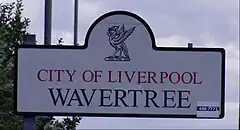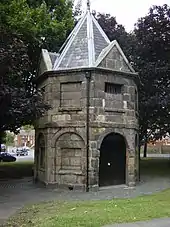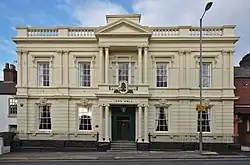Wavertree
Wavertree is a district of Liverpool, England. It is a ward of Liverpool City Council, and its population at the 2011 census was 14,772.[1] Located to the south and east of the city centre, it is bordered by various districts and suburbs such as Childwall, Edge Hill, Fairfield, Mossley Hill, Old Swan, and Toxteth.
| Wavertree | |
|---|---|
 | |
 Wavertree Location within Merseyside | |
| Population | 14,772 (2011) |
| OS grid reference | SJ3889 |
| Metropolitan borough | |
| Metropolitan county | |
| Region | |
| Country | England |
| Sovereign state | United Kingdom |
| Post town | LIVERPOOL |
| Postcode district | L15 |
| Dialling code | 0151 |
| Police | Merseyside |
| Fire | Merseyside |
| Ambulance | North West |
| UK Parliament | |
History

Within the boundaries of the historic county of Lancashire, the name derives from the Old English words wæfre and treow, meaning "wavering tree", possibly in reference to aspen trees common locally.[2] It has also been variously described as "a clearing in a wood" or "the place by the common pond".[3] In the past, the name has been spelt Watry, Wartre, Waurtree, Wavertre and Wavertree. The earliest settlement of Wavertree is attested to by the discovery of Bronze Age burial urns in Victoria Park in the mid-1860s,[3][4] while digging the footings for houses, two of which were built for Patrick O Connor, patentee, ironmonger, merchant and chair to the Wavertree Local Board of Health.[5]
The Domesday Book reference is "Leving held Wauretreu. There are 2 carucates of land. It was worth 64 pence". Wavertree was part of the parish of Childwall in the West Derby Hundred.
Wavertree also boasts a village lock-up, commonly known as The Roundhouse, despite being octagonal in shape. Built in 1796, and later modified by prominent local resident and architect Sir James Picton, it was once used to detain local drunks. The lock-up was made a listed building in 1952.[6] A similar structure, Everton Lock-Up sometimes called Prince Rupert's Tower, survives in Everton. The village green, on which Wavertree's lock-up was built, is officially the only surviving piece of common land in Liverpool.[6]
In 1895, the village of Wavertree was incorporated into the city of Liverpool. Buildings of interest include Holy Trinity Church, Liverpool Reform Synagogue, the Blue Coat School, and the Royal School for the Blind, all of which are situated on the same road. King David High School, a Jewish-affiliated school that also accepts students of other faiths and backgrounds, is situated in Wavertree and has a primary school attached to it. Wavertree Town Hall was built in 1872 as the headquarters of the Wavertree Local Board of Health. Rescued from demolition in 1979, the town hall is now a restaurant.[7]
Wavertree is one of the areas in south Liverpool populated by students of Liverpool's three universities, especially the Smithdown Road area. This road is known for "The Smithdown Ten" pub crawl, although the number of pubs in business varies from year to year.[8] Wavertree is also home to the annual Smithdown Road Festival, with local bars and cafes hosting almost 200 bands every year. The community is ethnically diverse, with significant South Asian and black populations.
Governance
The elected councillors for Wavertree are Angela Coleman, Clare McIntyre and Dave Cummings, all of whom are members of the Labour Party. It has been represented since 2019 by Paula Barker, also of the Labour Party, in the parliamentary constituency of Liverpool Wavertree.
Education
There are a number of both primary and secondary schools in this densely populated area of Liverpool. In addition to the aforementioned Blue Coat School, Royal School for the Blind, and King David High School, there is also Wavertree Church of England School, which was renamed from Trinity District in the 1990s. The school celebrated its 150th birthday in September 2017. There is another primary school on South Drive called Our Lady of Good Help. This used to be located in Chestnut Grove next to our Lady's Roman Catholic Church, which is now facing re-development. St Clare's Roman Catholic Primary School is also situated off Smithdown Road.
Wavertree Playground (The Mystery)
Wavertree Playground, known locally as The Mystery, was one of the first purpose-built public playgrounds in the UK. Opened in 1895, it is based on land donated to Liverpool Corporation by an anonymous donor (hence its nickname) to be a venue for organised sports, and a place for children from the city's schools to run about in, not a park for "promenading" in the Victorian tradition.[9] The donor expressed the hope that the City Council "might approve of giving it a fair trial for this purpose ... before appropriating it for any other use".
The land is currently home to Wavertree Athletics Centre, which boasts many sports facilities including tennis courts, an all-weather pitch, a bowling green, and an athletic track with grandstand. It also houses Liverpool Aquatics Centre, with two swimming pools, a sports hall, and a lifestyles fitness centre. The athletics centre has produced Olympic athletes such as Katarina Johnson-Thompson, who trains with the Liverpool Harriers team that has made its headquarters at the centre since 1990.
Notable people
- Frederick Noel Ashcroft, mineral collector and photographer
- Ross Barkley, footballer
- Tony Bellew, boxer
- Joan Benesh, choreographer and dancer
- Augustine Birrell, barrister, politician, and writer
- Kim Cattrall, actress
- Kenneth Cope, actor
- Paul Dawber, actor
- Paul Draper, musician
- Georgia May Foote, actress
- Cyril Edward Gourley, soldier
- John Gregson, actor
- Chelcee Grimes, singer-songwriter
- George Harrison, musician
- Stewart Duckworth Headlam, priest
- Holly Johnson, singer
- Bill Kenwright, theatre director
- John Lennon, musician
- Norman Rossington, actor
- Leonard Rossiter, actor
- Bertram Peel, cricketer
- Denis Peel, cricketer
- Jimmy Tarbuck, comedian
- James Valiant, cricketer
- Dora Yates, linguist, Romani scholar. She lived in Marmion Road.[10]
Transport
- Wavertree Technology Park railway station
- Train times and station information for Wavertree from National Rail
References
- "City of Liverpool Ward population 2011". Retrieved 12 January 2016.
- Placenames: Wavertree, National Museums Liverpool, retrieved 19 March 2008
- Wavertree History (PDF), Wavertree Cricket Club, ISBN 0-7524-3068-8, archived from the original (PDF) on 3 October 2011, retrieved 19 March 2008
- "Burial Urn".
- "Patrick O Connors Number 11 door spring".
- The Village Green and Lock-up, Discovering Historic Wavertree, archived from the original on 14 August 2007, retrieved 19 March 2008
- Wavertree Town Hall, Discovering Historic Wavertree, archived from the original on 14 August 2007, retrieved 19 March 2008
- Graves, Steve (30 July 2013). "Bell rings for last orders on 'Smithdown Ten' pub crawl". liverpoolecho.
- Wavertree Playground ('The Mystery'), Discovering Historic Wavertree, archived from the original on 14 August 2007, retrieved 19 March 2008
- 1939 register
